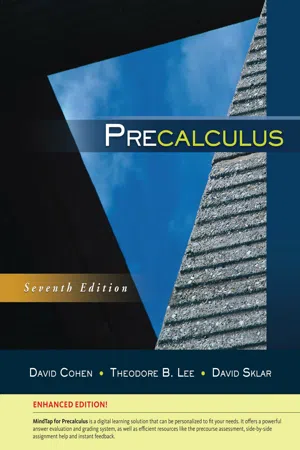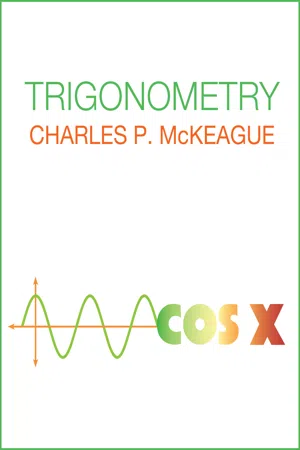Mathematics
Arc Measures
Arc measures refer to the size of an arc in a circle, typically measured in degrees. The measure of an arc is equal to the measure of its corresponding central angle. This concept is important in geometry and trigonometry for understanding angles and their relationship to circles.
Written by Perlego with AI-assistance
Related key terms
1 of 5
7 Key excerpts on "Arc Measures"
- eBook - PDF
- David Cohen, Theodore Lee, David Sklar, , David Cohen, Theodore Lee, David Sklar(Authors)
- 2016(Publication Date)
- Cengage Learning EMEA(Publisher)
However, for the more analytical portions of trigonometry and for calculus, radian measure is most often used. The radian measure of an angle is defined as follows. Copyright 201 Cengage Learning. All Rights Reserved. May not be copied, scanned, or duplicated, in whole or in part. Due to electronic rights, some third party content may be suppressed from the eBook and/or eChapter(s). Editorial review has deemed that any suppressed content does not materially affect the overall learning experience. Cengage Learning reserves the right to remove additional content at any time if subsequent rights restrictions require it. 7.1 Radian Measure 469 Definition The Radian Measure of an Angle Place the vertex of the angle at the center of a circle of radius r . Let s denote the length of the arc intercepted by the angle, as indicated in Figure 4. The radian measure u of the angle is the ratio of the arc length s to the radius r . In symbols, (1) In this definition it is assumed that s and r have the same linear units. u s r r s ¨ Figure 4 The radian measure u is defined by the equation u s r . EXAMPLE 1 Calculating the Radian Measure of an Angle Determine the radian measure for each angle in Figure 5. SOLUTION In Figure 5(a) we have r 6 cm, s 15 cm, and therefore So for the angle in Figure 5(a) we obtain u 5 2 radians. In the calculations just completed, notice that although both s and r have the dimensions of length, the resulting radian measure s r is simply a real number with no dimensions. (The dimensions “cancel out.” Note: When we write u 5 2 radians, we do not think of radians as a dimension, but we are indicating that we are interpreting the ratio 5 2 as the measure of an angle.) Before carrying out the calculations for the radian measure in Figure 5(b), we have to arrange matters so that the same unit of length is used for the radius and the arc length. - eBook - PDF
Sixth Form Pure Mathematics
Volume 1
- C. Plumpton, W. A. Tomkys(Authors)
- 2014(Publication Date)
- Pergamon(Publisher)
Two important results associated with circular measure follow: (a) The length of an arc which subtends an angle of d c at the centre of a circle of radius r is -^-XlTtr = rd. (4.13) P.M. 1—E 120 SIXTH FORM PURE MATHEMATICS (b) The area of a sector of angle 0 C of a circle of radius r is 0 2n Xnr 2 = | r 2 0 . (4.14) An important inequality and an important limit. PQ is an arc of a circle, radius r, subtending an angle 0 C (<-|-7r) at the centre O and the tangent at P meets OQ produced at T(Fig. 43). Then assuming that area of AOPT > area of sector OPQ > area of AOPQ, Fig. 43. and if the results (4.13) and (4.14) are assumed, | r 2 t a n 0 >r*B > | -r 2 s i n 0 ; tan 0 > 0 > sin 0 (0 < -^ ) . (4.15) Division of result (4.15) throughout by sin 6 gives l/cos0 > 0/sin0 > l and, since lim (1/cos 0) = 1, .'. Iim(0/sin0) = 1 . (4.16) This very important result is a property of the circular measure of an angle and is not true of angles measured in sexagesimal measure. Many of the results which follow in this chapter and the next are based on the formulae of this section and future references to the magnitude of an angle will assume that the angle is measured in circular measure unless it is stated otherwise. THE CIRCULAR FUNCTIONS 121 Examples, (i) Calculate the length of the arc which subtends an angle of 52° at the centre of a circle of radius 2.5 cm. Arc = rd where 6 is measured in radians. From the tables 52° = 0.9076 c . Therefore arc = 2.5X0.9076 cm = 2.27 cm correct to 3 sig. figures. (ii) Calculate the angle, in degrees correct to the nearest degree, of a sector of a circle of radius 5.31 cm and area 29.2 cm 2 : Area of sector = -r 2 d (0in radians); . 29.2 = -(5.31) 2 0; .. 0 == 2.07 c (by logarithms), == 119° (from the tables). In calculations involving very small angles the values of the sine and the tangent given by four-figure tables are accurate for those angles to very few significant figures. - eBook - PDF
- Paul A. Calter, Michael A. Calter(Authors)
- 2011(Publication Date)
- Wiley(Publisher)
405 Radian Measure, Arc Length, and Rotation ◆◆◆ OBJECTIVES ◆◆◆◆◆◆◆◆◆◆◆◆◆◆◆◆◆◆◆◆◆◆◆◆◆◆◆◆◆◆◆◆◆◆◆◆◆◆◆◆◆◆◆◆◆◆◆◆◆◆ When you have completed this chapter, you should be able to • Convert angles between radians, degrees, and revolutions. • Write the trigonometric functions of an angle given in radians. • Compute arc length, radius, or central angle. • Compute the angular velocity of a rotating body. • Compute the linear speed of a point on a rotating body. • Solve applied problems involving arc length or rotation. ◆◆◆◆◆◆◆◆◆◆◆◆◆◆◆◆◆◆◆◆◆◆◆◆◆◆◆◆◆◆◆◆◆◆◆◆◆◆◆◆◆◆◆◆◆◆◆◆◆◆◆◆◆◆◆◆◆◆◆◆◆◆◆◆ Many objects in technology spin at constant speed: wheels, CDs, hard drives, gears, pulleys, motors, shafts, and the earth itself, rotating about its axis. In this short chapter we will develop the math to deal with these applications. We also need to be able to find the distance between two points on a circle, such as two locations on a band of a computer disk, or two points on a great or small circle on the globe. We should be able to find out, for example, how far the rack of Fig. 14–1 will move when the pinion (the small gear) rotates, say, Our main tool for both arc length and rotation will be radian measure. We in- troduced radian measure earlier, but here we give it full treatment. Up to now we have usually used degrees as our unit of angular measure, but we will see that the radian is more useful in many cases. The reason is that the radian is not an arbitrary unit like the degree (why 360 degrees in a revolution rather than, say, 300?). The radian uses a part of the circle itself, (the radius) as a unit. This chapter also marks our return to trigonometry, with which we last studied right and oblique triangles. It will be followed by a few more chapters on trigonometry. 300°. 14 Pitch diameter = 22.5 mm Rack Pinion FIGURE 14–1 Rack and pinion. - eBook - PDF
- Daniel C. Alexander, Geralyn M. Koeberlein(Authors)
- 2019(Publication Date)
- Cengage Learning EMEA(Publisher)
Similarly, the entire circle can be separated into 360 equal arcs, each of which measures 1° of arc measure; that is, each 1uni00B0 arc would be intercepted by a central angle measuring 1°. Our description of arc measure leads to the following postulate. POSTULATE 16 ■ Central Angle Postulate In a circle, the degree measure of a central angle is equal to the degree measure of its intercepted arc. If m AB C 5 90uni00B0 in Figure 6.8, then muni2220AOB 5 90uni00B0. The reflex angle that intercepts BCA C and that is composed of three right angles measures 270°. In the same figure, m AB C 5 90uni00B0, mBCD C 5 180uni00B0 , and mAD C 5 90uni00B0 . It follows that m AB C 1 mBCD C 1 mAD C 5 360uni00B0 . Consequently, we have the following generalization. The sum of the measures of the consecutive arcs that form a circle is 360°. In }Y [Figure 6.9(a)], if muni2220XYZ 5 76uni00B0, then m XZ C 5 76uni00B0 by the Central Angle Postulate. If two arcs have equal degree measures [Figure 6.9(b) and (c)] but are parts of two circles with unequal radii, then these arcs will not coincide. Such observations lead to the following definition. In a circle, the length of a diameter is twice the length of a radius; in symbols, d 5 2r. O N M Q P 1 2 3 A D O B C Figure 6.6 O A C 1 2 D B Figure 6.7 Figure 6.8 6.1 ■ Circles and Related Segments and Angles 281 In a circle or congruent circles, congruent arcs are arcs with equal measures. DEFINITION POSTULATE 17 ■ Arc-Addition Postulate If AB C and BC C intersect only at point B, then m AB C 1 mBC C 5 mABC C . When m AB C 1 m BC C 5 m BC C as in Figure 6.12(a) on page 282, we say that point B is between A and C of circle O. Given points A, B, and C on }O as shown in Figure 6.12(a), suppose that radii OA , OB , and OC are drawn. Just as muni2220AOB 1 muni2220BOC 5 muni2220AOC by the Angle-Addition Postulate, it follows that m AB C 1 m BC C 5 mABC C . EXAMPLE 3 In }O of Figure 6.11, OE > bisects uni2220AOD. - No longer available |Learn more
- Daniel C. Alexander, Geralyn M. Koeberlein, , , Daniel C. Alexander, Geralyn M. Koeberlein(Authors)
- 2014(Publication Date)
- Cengage Learning EMEA(Publisher)
268 CHAPTER 6 ■ CIRCLES Unless otherwise noted, all content on this page is © Cengage Learning. In this chapter, we will expand the terminology for circles that was found in Section 1.2. We also introduce some methods of measurement of arcs and angles and develop many properties of the circle. A circle is named by its center point. In Figure 6.1, point P is the center of the circle. The symbol for circle is , so the circle in Figure 6.1 is . Points A, B, C, and D are points of (or on ) the circle. Points P (the center) and R are in the interior of circle P ; points G and H are in the exterior of the circle. In of Figure 6.2, is a radius of the circle. A radius is a segment that joins the center of the circle to a point on the circle. , , , and are radii (plural of radius ) of . By definition, ; more generally, the following statement is a consequence of the definition of a circle. SQ TQ VQ WQ Q WQ VQ TQ SQ SQ Q P A line segment (such as in Figure 6.2) that joins two points of a circle is a chord of the circle. A diameter of a circle is a chord that contains the center of the circle; if T-Q-W in Figure 6.2, then is a diameter of . Q TW SW In Figure 6.3 on page 269, circles P and Q are congruent because their radii have equal lengths. We can slide to the right to coincide with . Q P Circle Congruent Circles Concentric Circles Center Radius Diameter Chord Semicircle Arc Major Arc Minor Arc Intercepted Arc Congruent Arcs Central Angle Inscribed Angle KEY CONCEPTS Circles and Related Segments and Angles 6.1 D P R A B C G H S Q V T W W arning If the phrase “in a plane” is omitted from the definition of a circle, the result is the definition of a sphere. Figure 6.1 A circle is the set of all points in a plane that are at a fixed distance from a given point known as the center of the circle. DEFINITION All radii of a circle are congruent. Figure 6.2 Congruent circles are two or more circles that have congruent radii. - eBook - PDF
- Ron Larson(Author)
- 2021(Publication Date)
- Cengage Learning EMEA(Publisher)
All Rights Reserved. May not be copied, scanned, or duplicated, in whole or in part. Due to electronic rights, some third party content may be suppressed from the eBook and/or eChapter(s). Editorial review has deemed that any suppressed content does not materially affect the overall learning experience. Cengage Learning reserves the right to remove additional content at any time if subsequent rights restrictions require it. 4.1 Radian and Degree Measure 261 GO DIGITAL Radian Measure The amount of rotation from the initial side to the terminal side determines the measure of an angle. One way to measure angles is in radians. This type of measure is especially useful in calculus. To define a radian, use a central angle of a circle, which is an angle whose vertex is the center of the circle, as shown in Figure 4.5. The circumference of a circle is 2π r units, so it follows that a central angle of one full revolution (counterclockwise) corresponds to an arc length of s = 2π r. Moreover, 2π ≈ 6.28, so there are just over six radius lengths in a full circle, as shown in Figure 4.6. The units of measure for s and r are the same, so the ratio sr has no units—it is a real number. The measure of an angle of one full revolution is sr = 2π rr = 2π radians. Here are the measures of some other angles. 1 2 revolution = 2π 2 = π radians 1 4 revolution = 2π 4 = π 2 radians 1 6 revolution = 2π 6 = π 3 radians 1 8 revolution = 2π 8 = π 4 radians These and other common angles are shown below. π 6 π 4 π 3 π 2 π π 2 Recall that the four quadrants in a coordinate system are numbered I, II, III, and IV. The figure below shows which angles between 0 and 2π lie in each of the four quadrants. An angle whose terminal side lies on the x- or y-axis, such as 0, π 2, π , or 3π 2, is a quadrantal angle. The terminal sides of quadrantal angles do not lie within quadrants. Note that angles between 0 and π 2 are acute angles and angles between π 2 and π are obtuse angles. - eBook - PDF
- Charles P. McKeague(Author)
- 2020(Publication Date)
- XYZ Textbooks(Publisher)
119 3 iStockphoto.com © ventdusud RADIAN MEASURE Chapter Outline 3.1 Reference Angle 3.2 Radians and Degrees 3.3 Definition III: Circular Functions 3.4 Length of an Arc and Area of a Sector 3.5 Velocities Summary Test In Section 3.2, we will show how to convert back and forth between degrees and radians. Once we are able to do these conversions, we can apply all the material we have developed for degrees to radians. There are some interesting relationships that exist between the trigonometric functions we have have defined previously and the points on the unit circle. We cover these relationships and some material on even and odd functions in Section 3.3. In the last two sections of this chapter, we will apply the material from the first part of the chapter to circles in general. We will begin by deriving formulas for arc length and area and then proceed on to define angular velocity for points in motion on the circumference of a circle. The most important material in the chapter, from the standpoint of what is needed to continue on through the book, is the material in the first three sections. These are the sections in which you will be introduced to, and become familiar with, radian measure. In Chapter 4, when we graph the different trigonometric functions, we will work almost exclusively in radian measure. I n Chapters 1 and 2, we used degree measure exclusively to give the measure of angles. We will begin this chapter with another kind of angle measure called radian measure. Radian measure gives us a way to measure angles with real numbers instead of degrees. As you will see, there are a number of situations that occur in trigonometry for which real numbers are the more appropriate measure for angles. 120 Success Skills The study skills for this chapter are about attitude. They are points of view that point toward success. 1.
Index pages curate the most relevant extracts from our library of academic textbooks. They’ve been created using an in-house natural language model (NLM), each adding context and meaning to key research topics.






